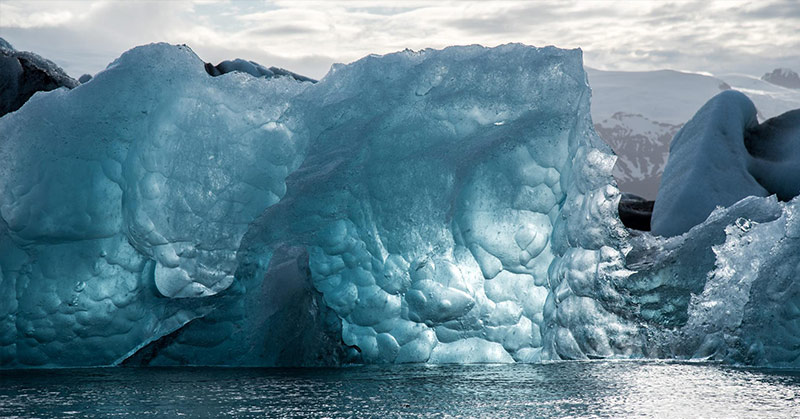With the current pandemic, it’s hard not to be a little on edge when someone mentions viruses. So we apologize if this adds to the anxiety, but in January researchers discovered an ice cap filled with over 30 previously unknown viruses.
An ice cap is a type glacier. This one is located in Central Asia, on the northwestern Tibetan Plateau of China, and has supposedly contained the viruses and bacteria for hundreds of thousands of years. Many of these viruses are unrecognizable to modern scientists.
The study was conducted by international researchers who traveled to explore ancient viruses in the Guliya ice cap. The preliminary reports have been published in bioRxiv and have not been peer-reviewed yet, which does mean that these reports should be taken with a grain of salt. [1]
Extracting Viruses Trapped in Ice
Glacial ice is capable of storing microscopic particles for thousands of years. Scientists use frozen contents of ice caps to make discoveries about the Earth’s history. Accurately sampling the ice can be tricky since outside/modern-day bacteria can contaminate them easily.
Two ice-core samples were taken from the Guliya ice cap in 1992 and in 2015. There weren’t any special measures taken during this process to avoid microbial contamination during the drilling, handling, or transport. This could have contaminated the outside of the ice core but the inside is still immaculate.
To access the interior of the ice cores, researchers built a cold room of 23 degrees Fahrenheit and cut 0.2 inches of ice from the outer layer with a sterilized band saw. Then they washed the ice cores with ethanol to melt another 0.2 inches. Then they used sterile water to wash away the next 0.2 inches. Finally, the researchers were able to study an uncontaminated layer.
“This study establishes ultra-clean microbial and viral sampling procedures for glacier ice, which complements prior in silico decontamination methods and expands, for the first time, the clean procedures to viruses,” the team wrote. [2]
Read: Evidence of 90-million-year-old rainforest uncovered beneath Antarctic ice
What They Found in the Ice
This ice was over 15,000 years old and they drilled 50 meters into it. They sampled two ice cores to learn about the microbes that were around at the time before they were trapped in the glacier.
Two cores were drilled, one at 6,200 meters and the other at 6,650 meters. To the surprise of scientists, conditions between these two cores differed in air temperatures, the oxygen concentration in the atmosphere, and UV radiation [3]. These ice cores trapped 33 different viruses and only four could be formally labeled; the rest were new and had never been studied before.
“The microbes differed significantly across the two ice cores,” the researchers wrote, “presumably representing the very different climate conditions at the time of deposition.“
When the researchers analyzed the microbes, they found that three viral populations were large, meaning these viruses have a good chance of being active, even in the ice. Many of the bacteria found are psychrophilic, which means they naturally grow and reproduce in low temperatures from −20°C to 10°C (–4°F to 50°F). Psychrophilic bacteria are found in regions that are always cold, like deep underwater, glaciers, and ice sheets. The bacteria found in the Guliya ice cap could be residing in a sort of storage box, and could be revived if the glacier melts someday.
The study included other tests that found 18 out of the 33 viruses had been linked to a host in the past. This indicates that they were infectious before the ice formed — and possibly still are now — and have spread to other populations of microbes. [3]
Melting Glaciers and Climate Change’s Unwanted Effects
Not much is known about the process of microbes becoming trapped in ice and how they survive and reproduce in this state for millennia. There have been only two previous reports of viruses being discovered in ice caps. The first was from a sample of a Greenland ice core 140,000 years old, and the second was found at the Vostok Station in East Antarctica at a depth from between 2,749 meters and 3,556 meters.
The study of the Guliya ice cap warns that glaciers are shrinking rapidly due to climate change. This can potentially release microbes and viruses that have been trapped and dormant for hundreds of thousands of years.
The idea of these viruses being may seem petrifying, especially as we live through a pandemic caused by a novel virus. However, researchers added that they believe this doesn’t seem likely.
“At a minimum, [ice melt] could lead to the loss of microbial and viral archives that could be diagnostic and informative of past Earth climate regimes,” the researchers wrote. “However, in a worst-case scenario, this ice melt could release pathogens into the environment.” [4]
They concluded stating that more research is needed to understand how microbes can affect the ice around them, how they have historically affected other bacteria, and how they would behave if the glacier was to melt.
- Zhi-Ping Zhong, Natalie E. Solonenko, Yueh-Fen Li, Maria C. Gazitúa, Simon Roux, Mary E. Davis, James L. Van Etten, Ellen Mosley-Thompson, Virginia I. Rich, Matthew B. Sullivan, Lonnie G. Thompson Glacier ice archives fifteen-thousand-year-old viruses. BioRxiv. https://www.biorxiv.org/content/10.1101/2020.01.03.894675v1 January 7, 2020
- Laura Geggel. Ancient never-before-seen viruses discovered locked up in Tibetan glacier. Live Science. https://www.livescience.com/unknown-viruses-discovered-tibetan-glacier.html January 22, 2020
- Isabella O’Malley. Dozens of previously unknown viruses discovered in 15,000-year-old glaciers. The Weather Network. https://www.theweathernetwork.com/ca/news/article/dozens-of-previously-unknown-viruses-discovered-in-15-000-year-old-glaciers January 29, 2020
- Kristin Hauser. Several Ancient Viruses Have Been Discovered in 15,000-Year-Old Glacial Ice. Science Alert. https://www.sciencealert.com/several-ancient-viruses-have-been-found-in-15-000-year-old-glacial-ice January 23, 2020

